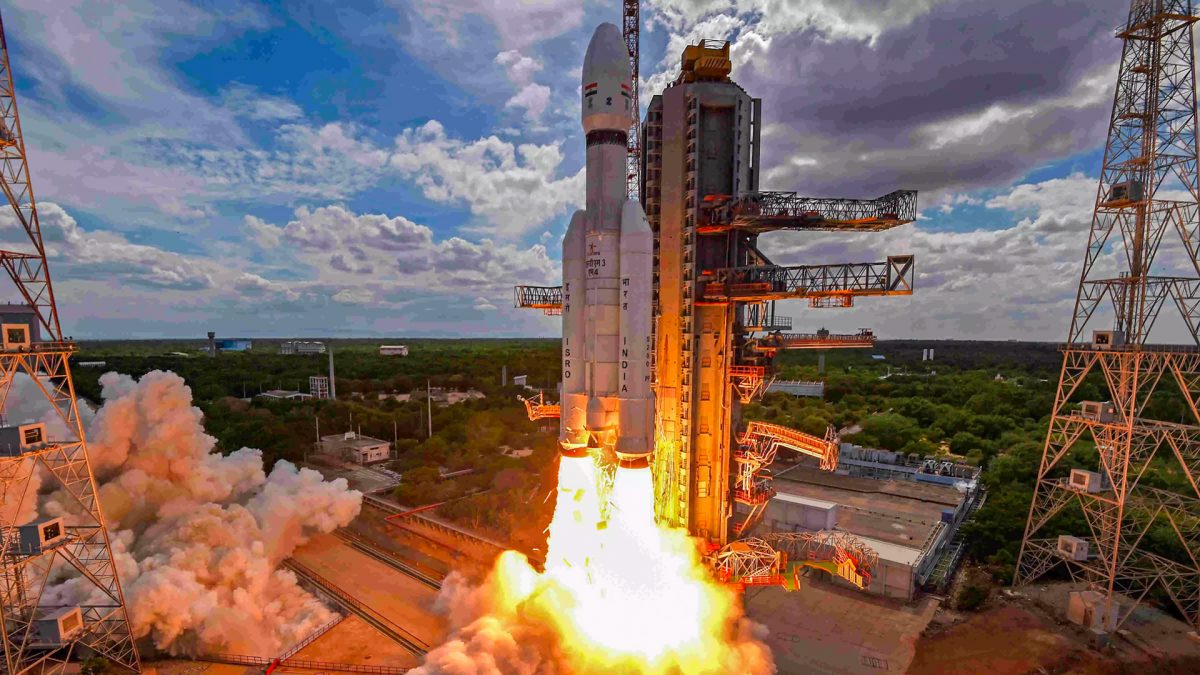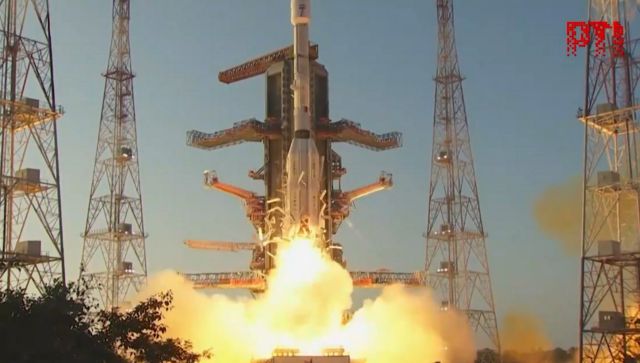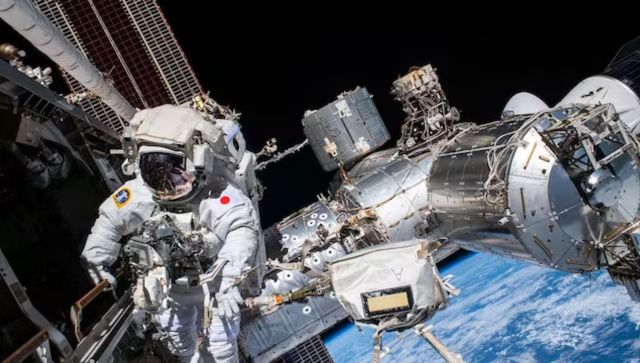Please follow the live blog for the launch of ISRO Satellite PSLV-C37.
The Indian Space Research Organisation (Isro) plans to set a world record by launching 104 satellites on board a Polar Satellite Launch Vehicle (PSLV) flight on 15 February. It will be the thirty ninth flight of the PSLV, and its sixteenth flight in the XL configuration, where additional motors are strapped onto the rocket.
The main payload is the Indian earth observation satellite, CartoSat-2D. The other 103 satellites are nanosatellites from India, Israel, Kazakhstan, the Netherlands, Switzerland, the United Arab Emirates (UAE) and the United States. The 101 foreign satellites are being launched as part of a commercial agreement between Isro and its commercial arm, Antrix.
Here are the details of the satellites on board.
CartoSat-2D
17 minutes into the launch, the CartoSat-2D will be the first to separate. The satellite has a mass of 714 kg and is the heaviest satellite on board. The CartoSat 2 series satellite will be injected into a 505 km Sun Synchronous Polar Orbit (SSPO), following which the satellite will be brought into an operational configuration. The CartoSat-2D is the fifth earth observation satellite in the CartoSat series, Isro had previously placed into orbit the CartoSat-2, CartoSat-2A, CartoSat-2B and CartoSat 2C.
The satellite will be used for providing remote sensing services and is equipped with panchromatic and multispectral image sensors. The images will be used for cartographic applications, urban and rural planning, monitoring of coastal land use, utility management such as road network monitoring, water distribution, mapping land use and change detection to identify natural and manmade features. The images will be used for a number of Land Information System (LIS) and Geographic Information System (GIS) applications.
The CartoSat-2D is powered by two solar panels and lithium ion batteries, and has its own fuel. The satellite can be controlled through reaction wheels, magnetic torquers and hydrazine thrusters. Various aspects of the satellite has been thoroughly tested on the ground, including a dynamic balancing test, a solar panel illumination test and a solar panel deployment test. The series of satellites are one of the most advanced imaging satellites launched by India, with a capacity to image the earth in sub meter resolutions. The planned operational period of the satellite is 5 years.
INS-1A
Isro Nano Satellite (INS) is a modular nanosatellite bus system, similar in concept to the CubeSat standard. The highly adaptable system is meant to be used for future experiments, student satellites and technology demonstration payloads. The INS-1A weighs 8.4 kg and has on board two science payloads. The Space Applications Centre (SAC), Ahmedabad has provided the Surface Bidirectional Reflectance Distribution Function Radiometer (SBR), and will be used to measure the amount of sunlight that gets bounced off different surface features.
The SAC has also provided the Single Event Upset Monitor (SEUM), which is an instrument to study the effects of high energy space radiation on commercial, off the shelf, electronic components. The INS-1A satellite is expected to be operational for 6 months.
INS-1B
The INS-1B is also a modular nanosatellite, and will be deployed into orbit after INS-1A. At 9.7 kg, INS-1B is slightly heavier than the other Indian nanosatellite on board. On board is an experimental payload from the SAC, an origami camera with a novel lens assembly that can take high resolution images of the Earth using a small package. The camera is a remote sensing colour camera, and there is a possibility that the imaging instrument will be used on regular satellites in the future.
The other payload is for deep space observations of the interplanetary hydrogen Lyman-alpha background flux, which is a particular type of excited hydrogen atom. The Earth Exosphere Lyman Alpha Analyser (EELA) will also record terrestrial exospheric line of sight neutral atomic hydrogen Lyman-alpha background flux (that’s quite a mouthful). The EELA payload is from the Laboratory of Electro-Optics Systems (LEOS), Bengaluru. The INS-1B has a planned mission life of 6 months.
Flock-3p
88 Dove satellites from Planet labs will be released in pairs. The satellites are part of a constellation of 100 Earth imaging satellites. The remaining 12 satellites in the constellation were also launched by India in the PSLV-C34 mission where Isro launched 20 satellites at once. The satellites will image the entire Earth once a day and will fly in a “line-scanner” formation with ideal mid-morning pass timings, which will provide a steady stream of imaging data.
The images obtained by Flock-3p will be used for commercial, humanitarian and environmental purposes. The 88 satellites are themselves a record of sorts for Isro and Planet Labs. The deployment of 88 satellites from a single rocket is the largest single fleet launch in history. The satellites will be put into a Sun Synchronous Orbit, at an altitude of 500 km. Dove satellites by Planet Labs make up the world’s largest constellation of earth imaging satellites, that are controlled by 30 ground stations around the world.
Lemur-2
There are 8 Lemur-2 nanosatellites based on the CubeSat standard. The Lemur satellites are owned and managed by Spire Global , and are a part of a constellation of satellites that track ships in open waters. Previous Lemur satellites have been launched on Cygnus, Antares, Atlas, Dnepr and from the International Space Station. The Automatic Identification System (AIS) is used for tracking ships, which is useful for real-time monitoring of large ships. The data is used by insurance companies, for the safety of the ships, to monitor illegal fishing and to take measures against piracy.
Apart from the ship tracking payload, the Lemur satellites are also equipped with instruments for monitoring the weather, which improves the accuracy of weather forecasts. The current weather satellites are aging and the total number of satellites providing weather data is diminishing. The weather forecasts are not very accurate or reliable, and are often meaningful only in the short term. A constellation of Lemur satellites hopes to rectify the situation and improve the accuracy of weather forecasts. Isro has previously launched 4 Lemur-2 satellites.
PEASSS
The PiezoElectric Assisted Smart Satellite Structure ( PEASSS ) is a 3 kg technology demonstration nanosatellite from the Netherlands. The satellite is meant to test and qualify cutting edge “smart structures”, which combine composite panels, piezoelectric materials and next generation sensors. The results of the technology demonstration will be disseminated to the industry through web sites, papers, presentations and courses.
The smart panels are useful for pointing the sensors and optical instruments on board, as well as generating power for the spacecraft. There are embedded optical fiber sensors to monitor the temperature and structural health of the satellite. The PEASSS is built by a European consortium of Partners, lead by Dutch research institute TNO and owned by Innovative Solutions in Space. Innovative Solutions in Space also had a role to play in getting the 88 satellites on the PSLV and acted as an intermediary between Planet Labs and Antrix.
DIDO-2
The DIDO-2 is a 4.2 kg microgravity research nanosatellite built by SpacePharma from Switzerland. SpacePharma was founded by former heads of Israeli intelligence and satellite units. The satellite is a platform for conducting biochemical and physical experiments in microgravity, allowing scientists to investigate phenomena that are normally obscured by gravity on Earth. Currently, access to microgravity research is restricted to the International Space Station, which is prohibitively expensive.
SpacePharma allows customers, mainly pharmaceutical companies, to design experiments meant for space. The customers can monitor and control the experiments from their own location. The DIDO-2 is the first satellite to be launched by SpacePharma. There is a microscope on board that can beam back images to the researchers on request. On board is a custom SpacePharma SOC, that allows for real-time adjustments through a secured web interface. The DIDO-1 launch has been delayed; it was supposed to go up on a SpaceX Falcon 9.
BGUSat
The BGUSat is a 4.3 kg technology demonstration nanosatellite from Israel. Israeli Aerospace Industries has built the satellite in cooperation with students from the Ben Gurion University. The main objective of the mission is so that students can learn the planning and development of satellites. The students will learn about telemetry systems, attitude control, power, sensors and integration. There are deployable solar panels for power.
The payloads on board are a camera, a space GPS, and an optical communication system. The satellite will be launched in a sun synchronous orbit. A ground station has been established and will be manned for the uplink and downlink operations after the satellite launch. There is an automatic housekeeping program on board to monitor the communications and power functions. The BGUSat is based on the CubeSat architecture.
Al-Farabi-1
The Al-Farabi-1 is a 1.7 kg technology demonstration nanosatellite from Kazakhstan. The Al-Farabi-1 is the first student nanosatellite from Kazakhstan, and is built by the Al-Farabi Kazakh National University . The satellite started being developed in 2013 and will be launched in a 600 km high sun synchronous orbit. The main payload is a 3MP sensor. There are solar panels on all the sides of the satellite.
There are 4 sun sensors on board, a 3 axis magnetic sensor, a 3 axis gyro sensor, 3 reaction wheels and a 3 axis magnetorquer, which will all be used to control the satellite. A ground station has been built for downlink and uplink operations. The satellite will orbit around the earth fourteen times every day, with each orbit lasting 97 minutes. The BGUSat will take measurements of atmospheric radiation as well as image clouds for scientific purposes. The Al-Farabi-1 is also based on the CubeSat standard.
Nayif-1
The Nayif-1 is a 1.1 kg technology demonstration nanosatellite from the United Arab Emirates (UAE). The Nayif-1 has been built by the Mohammed Bin Rashid Space Centre in Dubai and the American University of Sharjah (AUS) and is the smallest and lightest passenger on board. The Nayif-1 is the first nanosatellite by UAE, and has been built by engineering students. The Nayif-1 was initially slotted to fly on board a Spacex Falcon 9.
The Nayif-1 will pass over the UAE twice a day. The morning pass will be used by students, whereas the evening pass is for amateur radio communications. The students have created a special ground station for receiving telemetry data and have created a dashboard to display greeting messages in Arabic. The satellite will also collect a large amount of environmental space data. The Nayif-1 is based on the CubeSat standard.
PSLV-C37 will be launched from the First Launch Pad (FLP) from the Sriharikota High Altitude Range (SHAR), Satish Dhawan Space Centre (SDSC) at Sriharikota, Andhra Pradesh. The launch is scheduled for 9:28 AM IST, provided the weather conditions are favorable for a launch. DoorDarshan will have a pre-launch program and cover the launch operations live, which can be seen on television or YouTube.
This story is a part of a series on the world record launch of 104 satellites on a single mission by Isro. The stories in the series are:
- Isro aims for a World record, to launch 83 satellites on a single rocket
- ISRO to launch world record 100 satellites in the PSLV-C37 mission scheduled for February
- Launching 103 satellites is not about setting a record, but to maximise capability, says ISRO chief
- Isro adds another passenger to the PSLV-C37 mission, 104 satellite launch rescheduled to mid February
- Isro plans to involve Indian industries to increase satellite launch capacity
- Isro’s mid-February PSLV-C37 launch of 104 satellites to have 88 satellites from Planet Labs
- Isro chief AS Kiran Kumar outlines the various uses of Indian satellites to students
- Isro’s PSLV-C37 launch scheduled for 15 February at 9:00 AM, here are the confirmed details
- Isro is going to break these previous satellite launch records with the PSLV-C37 mission
- Isro to recover half the cost of record breaking PSLV-C37 launch from foreign customers
- Isro PSLV-C37 record breaking mission run up: A history of rockets and launch vehicles in India
- Isro PSLV-C37 mission: The US private sector is threatened by cheap Indian spaceflight
- Isro has plans to go to Venus and visit Mars again in the future, along with 104 satellites launch on 15 Feb
- Isro’s record breaking PSLV-C37 mission: These are the 104 satellites on board


)




)
)
)
)
)
)
)
)